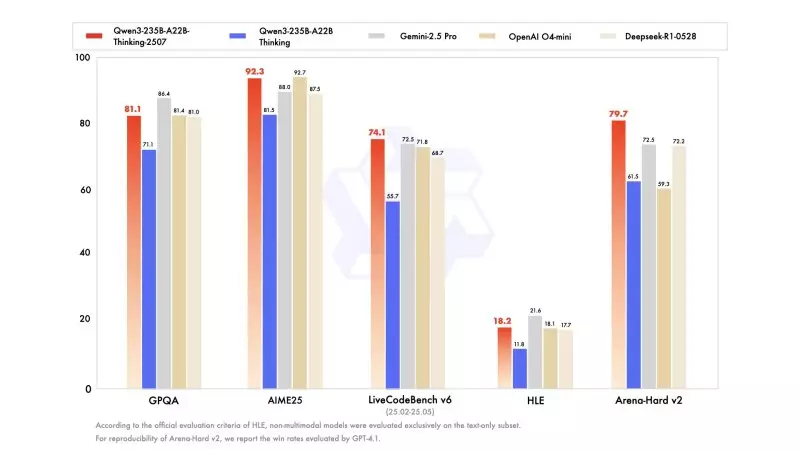In a landscape where proprietary giants dominate, a breath of fresh air has emerged from the depths of Alibaba’s visionary Qwen team. Their recent blitz of releases signals more than just technological progress; it symbolizes a fundamental shift towards open, transparent, and customizable artificial intelligence. While many industry players chase proprietary exclusivity, Alibaba’s commitment to open-source models underscores a belief that democratization of AI can propel innovation further and faster. This move challenges the entrenched narrative, emphasizing that accessibility doesn’t mean sacrificing performance—it can coexist with excellence.
The release of four cutting-edge models in a single week—culminating in the launch of Qwen3-235B-A22B-Thinking-2507—marks a revolutionary moment. These models don’t just push boundaries; they obliterate them, setting new benchmarks in a variety of complex tasks from reasoning to coding. At their core, these models exemplify a decisive departure from traditional, monolithic AI architectures, favoring specialized, purpose-built solutions that promise higher efficiency and greater adaptability. By choosing open licensing with Apache 2.0, Alibaba’s Qwen team not only liberates developers and enterprises to innovate without restrictions but also fosters a more competitive, vibrant AI ecosystem.
The Significance of Specialization in AI Models
One of the most insightful shifts from Alibaba’s recent strategy is their move away from hybrid reasoning models that intermingle tasks within a single, all-in-one model. Instead, they are now dedicating separate models for specific functions—be it reasoning, coding, or translation. This specialization enhances the performance of each model by allowing rigorous optimization aligned with its specific purpose. It’s a move grounded in practical wisdom: why dilute a model’s prowess with tasks that require fundamentally different approaches?
Take the flagship model, Qwen3-Thinking-2507. Its design prioritizes chains of thought, self-reflection, and iterative reasoning—traits crucial for tackling complex problems in mathematics, logic, and decision-making. Its superior results on benchmarks like AIME25 and LiveCodeBench v6 aren’t mere flukes; they demonstrate a significant leap forward in AI’s capacity to simulate human-like reasoning and problem-solving. This innovation pushes the industry toward models that aren’t just memorizing data but are genuinely processing and understanding complex scenarios.
Furthermore, the broader ecosystem Alibaba is building isn’t solely about one model’s raw power. It’s about creating a comprehensive toolkit—covering coding, translation, and instruction-following—accessible and scalable across diverse sectors. This approach recognizes that AI’s true potential lies not only in raw intelligence but in how seamlessly it can be integrated into real-world workflows, improving productivity, decision-making, and innovation.
The Open-Source Advantage and Its Strategic Implications
Perhaps the most compelling element of Alibaba’s strategy is their deliberate choice of licensing: Apache 2.0. Unlike restrictive licenses that confine the use of models behind APIs or commercial restrictions, this permissive license gives organizations full freedom. Enterprises can download, modify, run, and deploy these models within their proprietary systems, ensuring data privacy, cost control, and operational flexibility. This is a bold stance—especially in a market where major players often guard their models jealously behind closed doors.
This approach has far-reaching implications. For startups, research institutions, and large corporations alike, it levels the playing field. Suddenly, access to high-performance AI isn’t limited to those with vast resources or privileged agreements. Instead, it becomes a matter of technical skill and creativity. Alibaba’s move fosters a culture of innovation where organizations can truly own their AI solutions, customize them for niche needs, and even contribute back to the ecosystem—an open innovation cycle that benefits everyone.
Moreover, by providing models compatible with widely-used frameworks and APIs, Alibaba is lowering technical barriers. Whether running locally, integrating into existing software stacks, or deploying in cloud environments, organizations have flexibility. The model’s support for advanced features like long-context windows and agentic frameworks promises to influence enterprise AI deployment strategies profoundly, especially in complex domains like legal analysis, technical research, or multi-lingual translation.
Implications for the Future of AI Development
This strategic push by Alibaba signifies an inflection point in AI’s evolution. It challenges the narrative that cutting-edge AI must be proprietary, opaque, or exclusively in the hands of tech giants. Instead, the emphasis on open-source, highly optimized, task-specific models illustrates a future where AI is democratized, customizable, and ultimately more trustworthy.
The industry must reckon with this reality: for AI to truly reach its potential, it needs community-driven development, transparency, and flexibility. Alibaba’s model release exemplifies this paradigm shift—showing that performance, openness, and commercial viability can coexist. As more organizations adopt and adapt these models, the landscape of AI will become more diverse, resilient, and innovative.
What remains to be seen is how other players will respond. Will they intensify their proprietary lock-ins or embrace the open ecosystem that Alibaba’s strategy embodies? The answer will significantly shape AI’s trajectory—not just from a technological standpoint but in terms of societal impact, ethical considerations, and global competitiveness. As Alibaba’s recent endeavors illustrate, the future belongs to those who prioritize freedom, collaboration, and a relentless pursuit of excellence without restrictions.


Leave a Reply